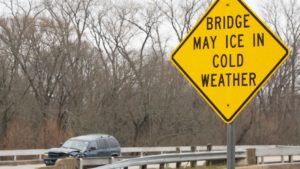This week, every county in Texas is facing temperatures we haven’t seen in decades, but the weather patterns pushing the frigid air started back in early January. The low in North Texas today could drop to 1 degree and wind chill values could plunge below zero. The last time Dallas-Fort Worth saw temperatures this cold was Dec. 23, 1989 when the low reached -1 degree. By Tuesday morning, lows could even dip below zero across North Texas, the National Weather Service said. Unfortunately, the cold weather also makes an impact on our electricity usage. We are using more energy to stay warm at the same time, the icy blast is damaging our electrical grid. This means that more than 1 million Texanswere without power for hours. The Electric Reliability Council of Texas said it expects rotating outages to last throughout Monday morning and last until “weather emergency ends.” But, if we all prepare a little more, we can make the cold weather bearable, according to the Dallas Morning News.
Here’s what to know about driving on snowy or icy roads, and keeping pets safe in cold temps
Though forecast details are still unclear, North Texas could see 3 to 6 inches of snow late Sunday into Monday morning, according to the National Weather Service.
An SUV (left) sits idle after hitting guardrails on the bridge located at the intersection of Bruton and S. 2nd Ave in east Dallas on Tuesday, Feb. 11, 2021.(Juan Figueroa / Staff photographer)
11:09 AM on Feb 4, 2020 CST — Updated at 12:19 PM on Feb 11, 2021 CST
Parts of this article were originally published Feb. 4, 2020. It has been updated and is being reshared because of the chance for snow Sunday, Feb. 14.
North Texans can handle the heat, but snow and ice are problems.
Freezing rain late Wednesday into Thursday produced icy roads across Dallas-Fort Worth, causing crashes and fatalities across the area. Now, snow could be on the way.
Although forecast details are uncertain, North Texas could see 3 to 6 inches of snow late Sunday into Monday morning, according to the National Weather Service.
“Significant travel impacts would result from such a storm, especially if models begin to trend toward the higher snow totals,” said Matt Stalley, a Weather Service meteorologist.
The Texas Department of Transportation and North Texas Tollway Authority crews began treating roads this week, using a mixture of salt and water called brine, which lowers the freezing point of water, but TxDOT urged drivers to use caution on icy or wet roads.
Driving on winter roads
What should you know about driving in wintry conditions? The National Weather Service offers the following tips:
- Reduce speed and allow plenty of space between you and the vehicle in front of you.
- Avoid making sharp turns or braking suddenly.
- If your vehicle skids, gently steer in the direction of the skid to regain control; resist the urge to jerk the steering wheel in the opposite direction.
- From a stop, accelerate slowly in second gear to get better traction.
- Sand, kitty litter or cardboard can help you regain traction if your vehicle gets struck.
- Take blankets, water, jumper cables, a flashlight and a tow rope, in case you get stranded.
1/13Mass casualty wreck on I-35W and Northside Drive in Fort Worth, Texas on Thursday, February 11, 2021. (Lawrence Jenkins/Special Contributor)(Lawrence Jenkins / Special Contributor)
Tips for the home
The road isn’t the only place people need to take precautions when the temperature plummets.
Experts have suggested these tips to prepare as the temperature dips below freezing.
- Check smoke detectors and fire extinguishers and ensure your chimney is clear and your fireplace safe before starting a fire.
- Check windows and doors to ensure they’re closed tightly and well insulated.
- Wrap pipes to insulate them from cold, and open kitchen and bathroom cabinets so warmer air can circulate around plumbing, especially if pipes are on an exterior wall.
- Let water drip from a faucet that is fed by exposed pipes so the trickle of water can help prevent the pipes from freezing.
- If you plan to be away from home when it’s extremely cold, be sure the heat is on high enough to ensure things won’t freeze.
- Keeping your garage closed is especially important if there’s a water supply line there.
- Ensure that your heating system has been inspected and maintained.
- Stock up on supplies that help you avoid making risky trips in slippery conditions.
- The cold already has been severe enough to harm some outdoor plants, but if it’s not too late: Bring them inside if you can. Gardeners suggest using sheets, drop cloths, blankets or plastic to cover vulnerable outside plants. Stakes cab help keep the material from touching the foliage. Coverings should be removed when temperatures rise the next day. Plantings also may be covered by mulch, such as straw, and plants in containers should be clustered together — in a sheltered spot close to the home is best.
Advice about pets
The American Veterinary Medical Association has a variety of advice for keeping pets safe from the cold.
Here are some key points:
Know your pets’ cold tolerance, which can vary because of their coat, body fat, activity level and health. Many dogs will need their walks shortened in very cold weather. Arthritic and elderly pets may have more difficulty on snow and ice. Pets with conditions such as diabetes and heart or kidney disease may struggle to regulate their body temperature, and extremely old and young pets may have the same challenge. Although long-haired or thick-coated dogs tend to handle the cold better, they can still be at risk.
Many people overestimate animals’ resistance to the cold. Cats and dogs are susceptible to frostbite and hypothermia. They really should be kept inside during cold weather. Huskies and other longer-haired and thick-coated breeds that are adapted to cold climates are more tolerant to the cold, but no pets should be left outside for long in extreme weather.
If dogs must be sheltered outside the home, they need constant access to fresh water — that won’t ice over. The floor of the shelter should be elevated, and bedding must be thick and kept dry. The entrance should be protected from the wind. Because space heaters and heat lamps may burn the animals or cause a fire, it’s best to find a way to move pets inside.
Although dogs may not be too enthusiastic about them, coats and sweaters can be beneficial, especially if they are short-haired breeds. Their paws also should be checked for ice or cracked pads or bleeding. Some people outfit their dogs with booties for anything more than a quick visit outside.
Strays need consideration, too. A warm vehicle engine can draw feral cats looking for a safe spot. Check underneath your car, bang on the hood, and honk the horn before starting the engine to ensure animals are clear of the vehicle.
Berkeys Air Conditioning, Plumbing & Electrical is a proud member of the Dallas / Fort Worth community, Our reliable, professional employees will help you keep your home’s systems running efficiently and safely so you can enjoy our great DFW metroplex.
When you need a dependable, knowledgeable plumber, electrician or HVAC technician in the Dallas/Ft. Worth area, call a name you trust. Berkeys Air Conditioning, Plumbing & Electrical 24/7, Call us at 877-746-6855 or visit berkeys.com for questions and scheduling information or on Facebook at Facebook.com/Berkeys.

